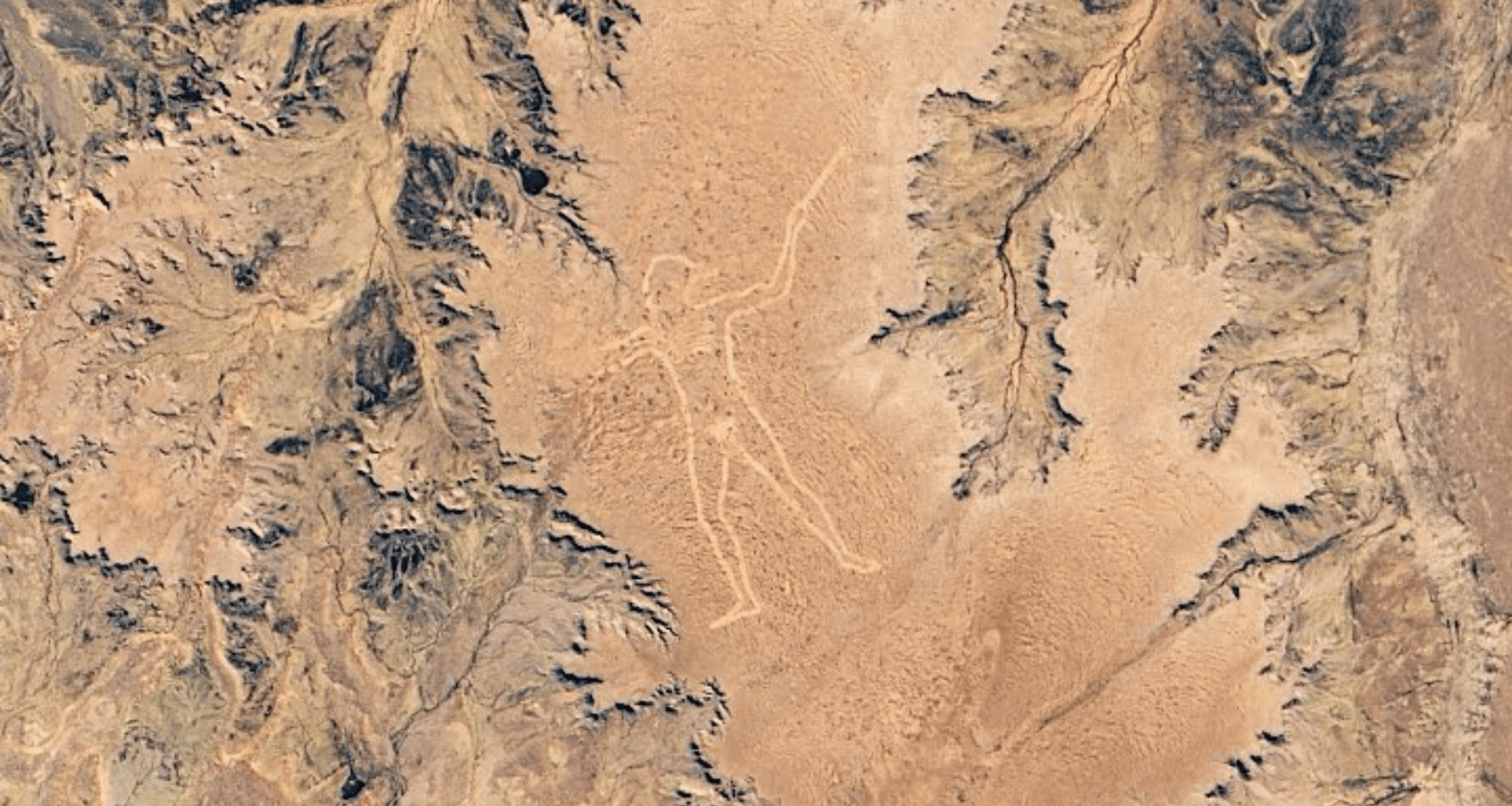In the desolate Australian outback, a massive geoglyph known as the Marree Man has captured the world’s attention for decades. This 2-mile-tall figure, which first appeared in 1998, depicts an Aboriginal Australian hunter with a boomerang. Despite numerous theories, the identity of the creator remains shrouded in mystery. Recent findings have only deepened the intrigue surrounding its origins.
The Marree Man: A Giant in the Outback
Stretching across 17 miles in perimeter and standing 2.2 miles wide, the Marree Man is one of the largest geoglyphs ever discovered. Unlike the ancient Nazca Lines of Peru, which date back centuries, the Marree Man’s origins are startlingly recent—only appearing in the late 1990s. Located on the Finniss Springs plateau, around 37 miles west of Marree, South Australia, the image of a naked Aboriginal hunter wielding a throwing stick or boomerang rises from the earth. Despite the vast scale of the figure, it remains unclear how it was made with such precision in such a short period. Live Science notes that satellite images taken by Landsat 8 in 2019 show a sharp outline, but the mystery of its creation still persists. Additionally, ABC News reports that experts continue to debate how the enormous artwork was created so rapidly, with no one definitively claiming responsibility for its construction.
The figure was first discovered by a charter pilot in 1998, and within weeks, an anonymous fax to local hotels confirmed its creation. Though the geoglyph became widely known as the Marree Man, it was initially referred to as “Stuart’s Giant.” The sheer size and precision of the lines, combined with the sudden appearance of the geoglyph, have led experts to speculate about the tools and techniques used to create it.

The Mystery of Its Creator
Despite widespread attention and a variety of theories, no one has officially claimed responsibility for creating the Marree Man. The most widely proposed creator is Bardius Goldberg, an Adelaide-based artist. Goldberg’s friends have suggested he confessed to making the geoglyph, but he never publicly took credit for it before his death in 2002. The mystery deepens with the discovery of a small plaque bearing the U.S. flag near the Marree Man’s head. This, along with the “Americanisms” present in the original anonymous fax, has led some to speculate that American personnel stationed at a nearby Royal Australian Air Force base might have been involved in its creation.
The theories about who created the Marree Man continue to fuel debates among historians, archaeologists, and even those familiar with the area. Some speculate that it could be a modern piece of indigenous-inspired artwork, while others suggest it may have been a collaboration of local individuals or even a promotional stunt. The true story behind the Marree Man’s creation, however, remains elusive.

Modern Technology and the Preservation Effort
In 2016, after years of erosion, the Marree Man was redrawn using GPS-guided technology, a move that ensured the geoglyph’s survival for future generations. Originally carved about 10 inches deep, the figure had nearly disappeared due to wind erosion. However, local business owners decided to recarve it using modern equipment, including commercial diggers and a GPS guidance system, which helped to retrace the lines more deeply and accurately. This careful redrawing of the Marree Man involved 60 hours of labor, ensuring that the giant figure would remain visible for years to come.
The team also incorporated new elements into the design, such as grooves that trap water, fostering the growth of vegetation around the geoglyph’s perimeter. This green border is intended to protect the lines from further erosion, making the figure more resistant to the harsh winds of the outback. While these efforts have helped preserve the Marree Man, the underlying mystery of its origins still stands.
A Cultural and Artistic Symbol
The Marree Man also represents a blend of modern artistry and cultural symbolism. Although its creator remains unidentified, the geoglyph reflects a respect for Aboriginal culture, with the image of an Aboriginal hunter clearly inspired by indigenous traditions. The portrayal of the hunter with a boomerang is a powerful symbol of the deep connection Aboriginal Australians have with the land and their traditions.
This massive artwork calls into question the role of modern technology in creating large-scale earthworks. In an era where aerial imagery and GPS systems can allow artists to craft such colossal figures, the Marree Man highlights the potential for new forms of creative expression. It also raises the question of how indigenous cultures might use technology to preserve and express their heritage in contemporary ways.
The Unsolved Puzzle: Why the Mystery Endures
The enigma of the Marree Man endures not only because of its size and intricacy but also because it taps into something deeply human—the desire to solve mysteries. Whether it’s the fascination with ancient wonders like the Nazca Lines or modern phenomena like crop circles, humanity has always been drawn to unexplained creations in the landscape. The Marree Man stands as a modern testament to this unyielding curiosity.
The mystery behind the figure’s origins may never be solved, but it remains a part of the cultural fabric of the Australian outback. Whether it was created by an artist, military personnel, or a group of individuals with a specific agenda, the Marree Man continues to captivate and inspire. Its legacy will likely endure long after the answers to its creation remain hidden beneath the sands of time.

